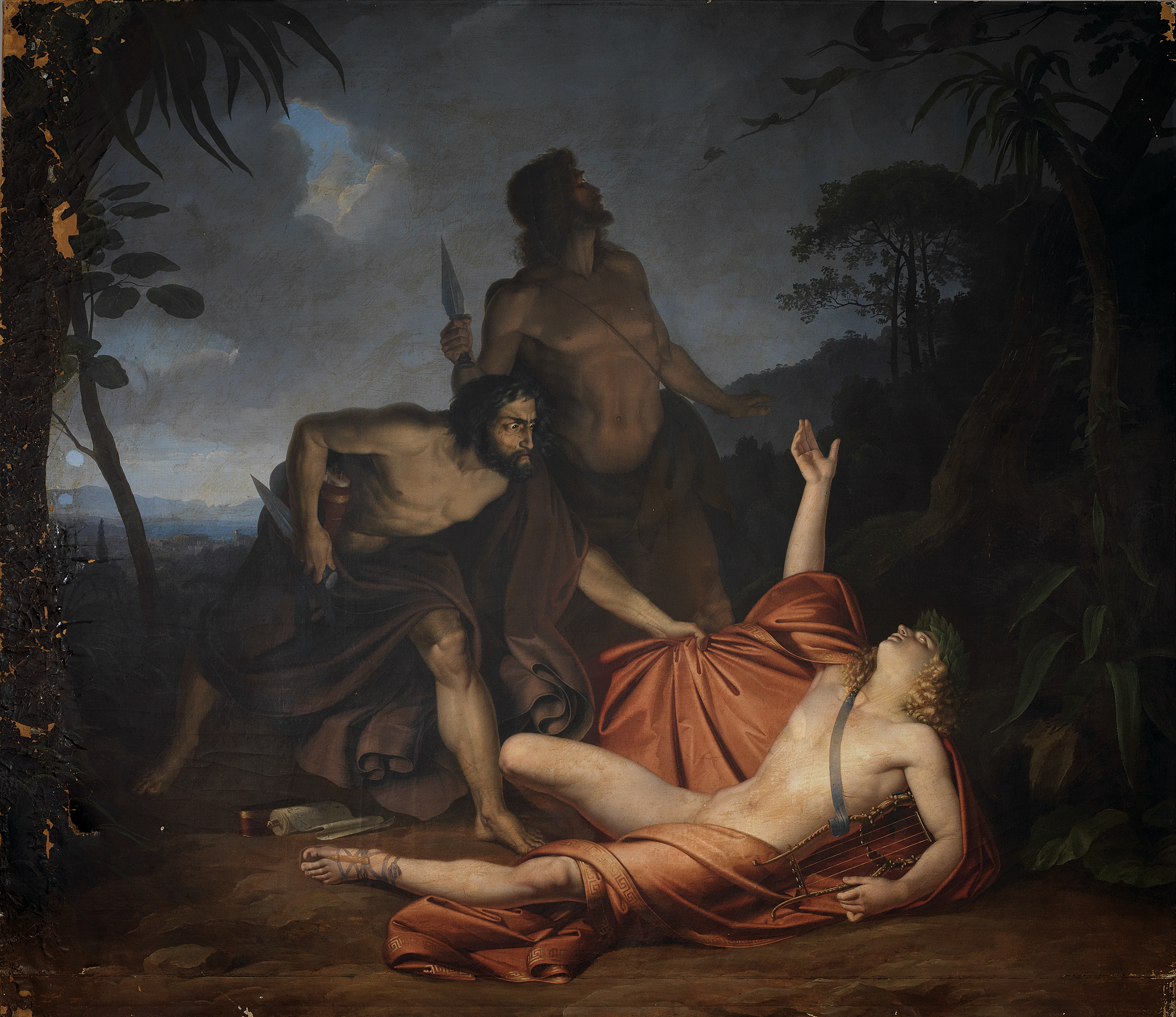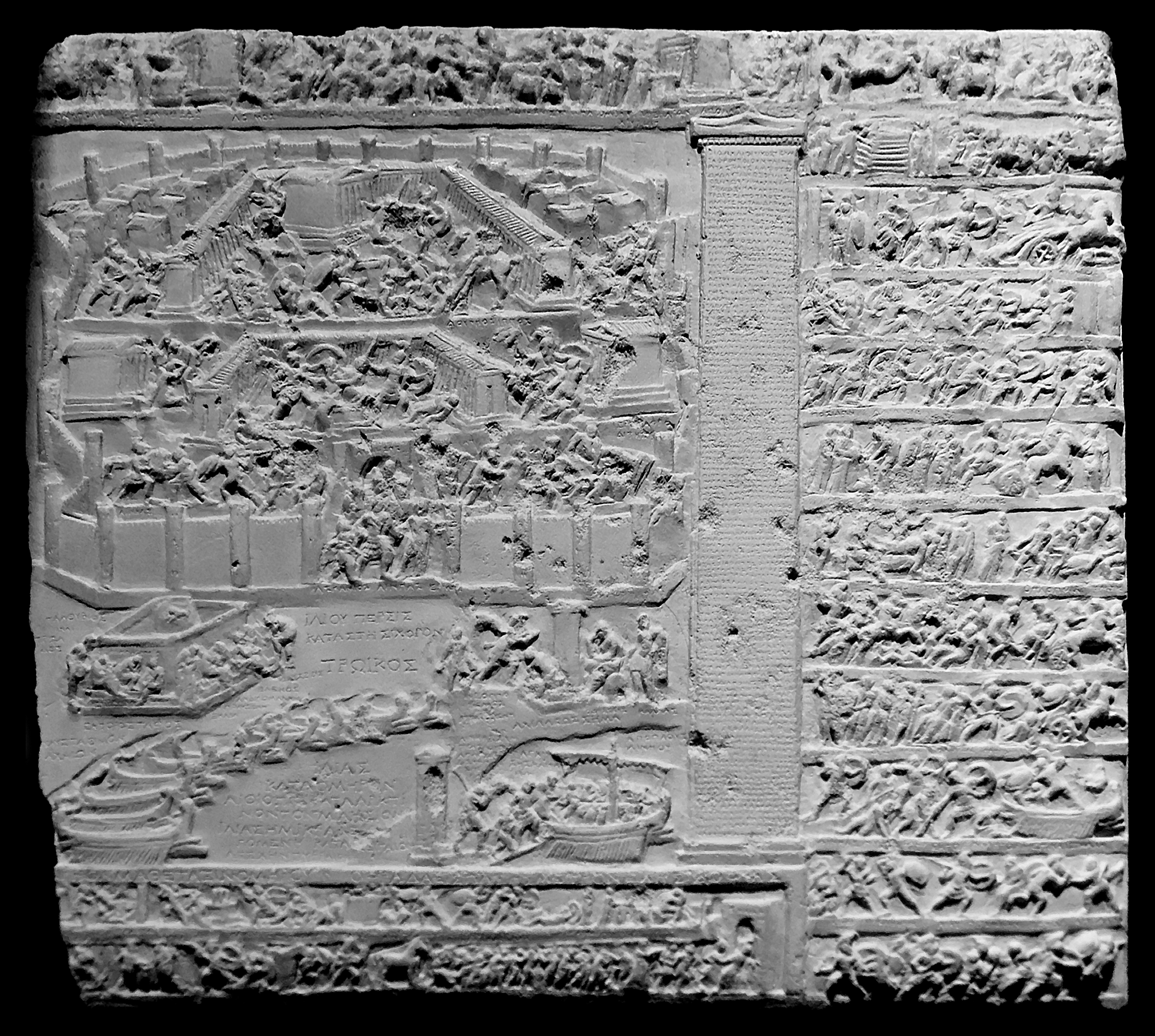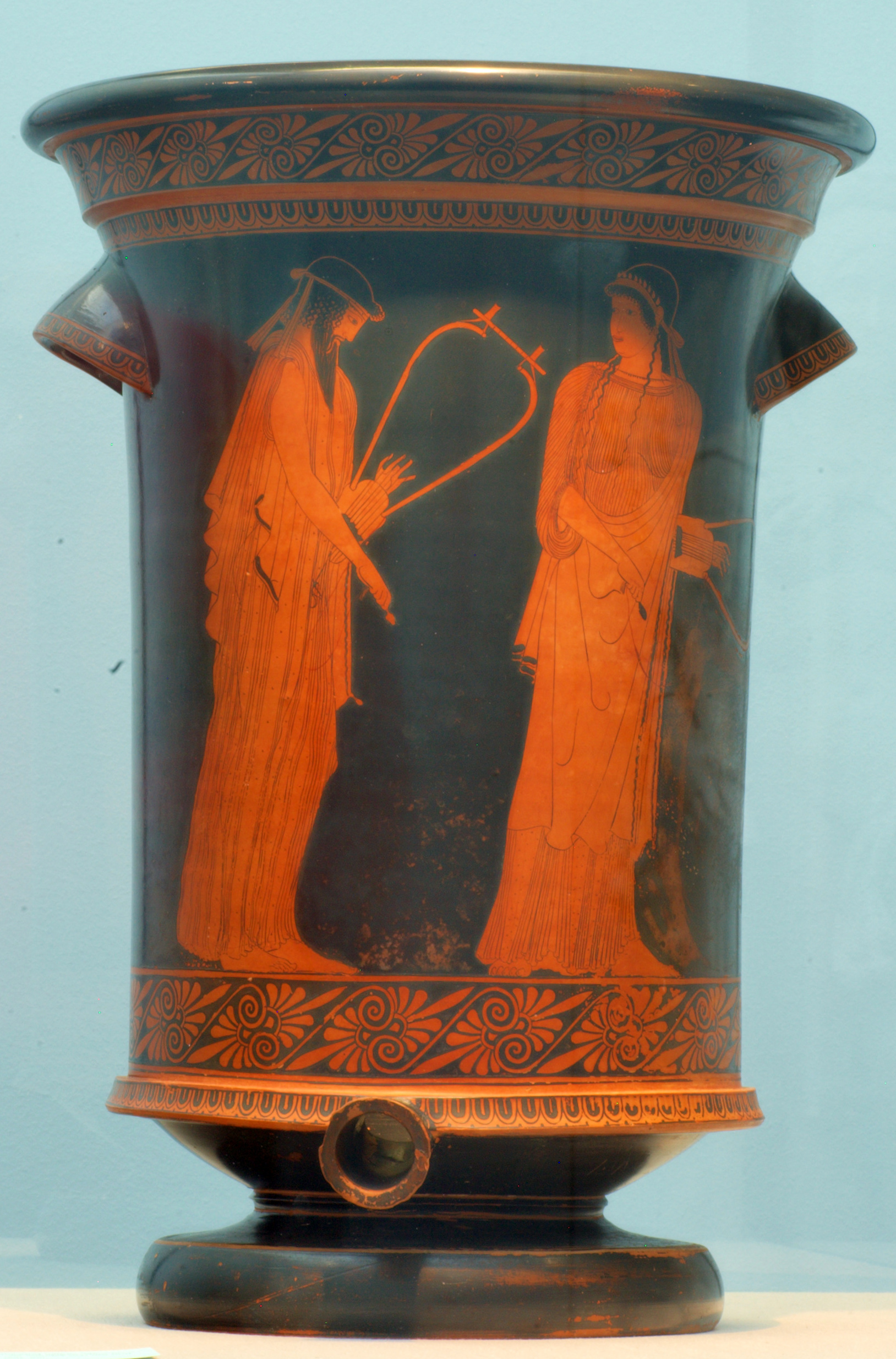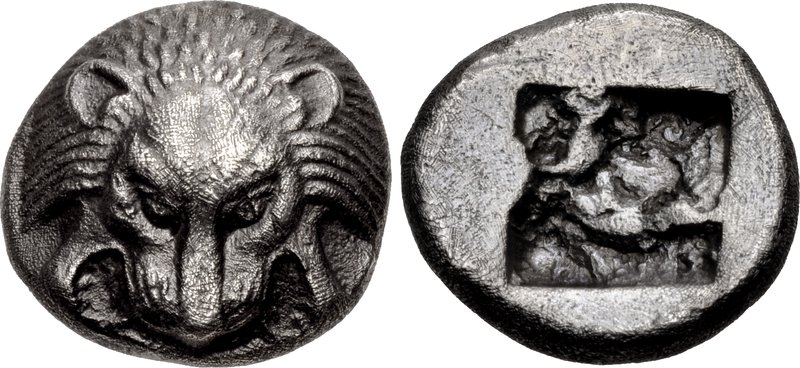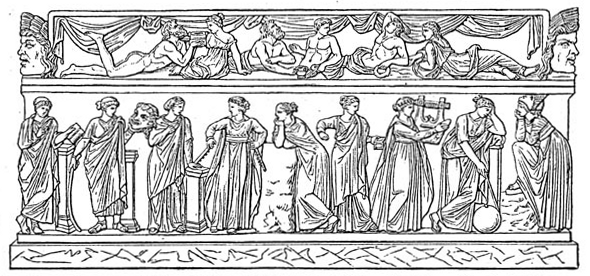|
Ibycus
Ibycus (; grc-gre, Ἴβυκος; ) was an Ancient Greek lyric poet, a citizen of Rhegium in Magna Graecia, probably active at Samos during the reign of the tyrant Polycrates and numbered by the scholars of Hellenistic Alexandria in the canonical list of nine lyric poets. He was mainly remembered in antiquity for pederastic verses, but he also composed lyrical narratives on mythological themes in the manner of Stesichorus.David A. Campbell, ''Greek Lyric III'', Loeb Classical Library (1991), page 8 His work survives today only as quotations by ancient scholars or recorded on fragments of papyrus recovered from archaeological sites in Egypt, yet his extant verses include what are considered some of the finest examples of Greek poetry. As is the case with many other major poets of ancient Greece, Ibycus became famous not just for his poetry but also for events in his life, largely the stuff of legend: the testimonia are difficult to interpret and very few biographical facts ar ... [...More Info...] [...Related Items...] OR: [Wikipedia] [Google] [Baidu] |
Stesichorus
Stesichorus (; grc-gre, Στησίχορος, ''Stēsichoros''; c. 630 – 555 BC) was a Greek lyric poet native of today's Calabria (Southern Italy). He is best known for telling epic stories in lyric metres, and for some ancient traditions about his life, such as his opposition to the tyrant Phalaris, and the blindness he is said to have incurred and cured by composing verses first insulting and then flattering to Helen of Troy. He was ranked among the nine lyric poets esteemed by the scholars of Hellenistic Alexandria, and yet his work attracted relatively little interest among ancient commentators, so that remarkably few fragments of his poetry now survive. As David Campbell notes: "Time has dealt more harshly with Stesichorus than with any other major lyric poet." Recent discoveries, recorded on Egyptian papyrus (notably and controversially, the Lille Stesichorus),P.J. Parsons, "The Lille Stesichorus", ''Zeitschreift für Papyrologie und Epigraphik'' Vol. 26 (1977), pages ... [...More Info...] [...Related Items...] OR: [Wikipedia] [Google] [Baidu] |
Die Kraniche Des Ibykus
Kraniche des Ibycus") is a ballad by Friedrich Schiller, written in 1797, the year of his friendly ballad competition with Goethe. It is set in the 6th century BC and based on the murder of Ibycus Ibycus (; grc-gre, Ἴβυκος; ) was an Ancient Greek lyric poet, a citizen of Rhegium in Magna Graecia, probably active at Samos during the reign of the tyrant Polycrates and numbered by the scholars of Hellenistic Alexandria in the canon .... External links * Poetry by Friedrich Schiller 1797 poems Ballads {{Poem-stub ... [...More Info...] [...Related Items...] OR: [Wikipedia] [Google] [Baidu] |
Crane (bird)
Cranes are a family, the Gruidae, of large, long-legged, and long-necked birds in the group Gruiformes. The 15 species of cranes are placed in three genera, '' Antigone'', '' Balearica'', and '' Grus''. Unlike the similar-looking but unrelated herons, cranes fly with necks outstretched, not pulled back. Cranes live on most continents, with the exception of Antarctica and South America. They are opportunistic feeders that change their diets according to the season and their own nutrient requirements. They eat a range of items from small rodents, eggs of birds, fish, amphibians, and insects to grain and berries. Cranes construct platform nests in shallow water, and typically lay two eggs at a time. Both parents help to rear the young, which remain with them until the next breeding season. Some species and populations of cranes migrate over long distances; others do not migrate at all. Cranes are solitary during the breeding season, occurring in pairs, but during the nonbreedin ... [...More Info...] [...Related Items...] OR: [Wikipedia] [Google] [Baidu] |
Greek Lyric
Greek lyric is the body of lyric poetry written in dialects of Ancient Greek. It is primarily associated with the early 7th to the early 5th centuries BC, sometimes called the "Lyric Age of Greece", but continued to be written into the Hellenistic and Imperial periods. Background Lyric is one of three broad categories of poetry in classical antiquity, along with drama and epic, according to the scheme of the "natural forms of poetry" developed by Goethe in the early nineteenth century. (Drama is considered a form of poetry here because both tragedy and comedy were written in verse in ancient Greece.) Culturally, Greek lyric is the product of the political, social and intellectual milieu of the Greek ''polis'' ("city-state"). Much of Greek lyric is occasional poetry, composed for public or private performance by a soloist or chorus to mark particular occasions. The symposium ("drinking party") was one setting in which lyric poems were performed.Miller, ''Greek Lyric: An Anthology ... [...More Info...] [...Related Items...] OR: [Wikipedia] [Google] [Baidu] |
Rhegium
Reggio di Calabria ( scn, label= Southern Calabrian, Riggiu; el, label=Calabrian Greek, Ρήγι, Rìji), usually referred to as Reggio Calabria, or simply Reggio by its inhabitants, is the largest city in Calabria. It has an estimated population of nearly 200,000 and is the twenty-first most populous city in Italy, after Modena, and the 100th most populated city in Europe. Reggio Calabria is located in the exact center of the Mediterranean and is known for its climate, ethnic and cultural diversity. It is the third economic centre of mainland Southern Italy. About 560,000 people live in the metropolitan area, recognised in 2015 by Italy as a metropolitan city. Reggio is located on the "toe" of the Italian Peninsula and is separated from the island of Sicily by the Strait of Messina. It is situated on the slopes of the Aspromonte, a long, craggy mountain range that runs up through the centre of the region. As a major functional pole in the region, it has strong historica ... [...More Info...] [...Related Items...] OR: [Wikipedia] [Google] [Baidu] |
Polycrates
Polycrates (; grc-gre, Πολυκράτης), son of Aeaces, was the tyrant of Samos from the 540s BC to 522 BC. He had a reputation as both a fierce warrior and an enlightened tyrant. Sources The main source for Polycrates' life and activities is the historian Herodotus, who devotes a large section of book 3 of his ''Histories'' to the rise and fall of Polycrates (3.39-60, 3.120-126). His account was written in the third quarter of the 5th century BC, nearly a century after Polycrates' death, was based mostly on oral traditions and incorporates many folk-tale elements. Furthermore, Herodotus creatively shaped his account of Polycrates in order to make general moral points and to comment on the imperialism of the Athenian empire in his own day. Some poetry from Polycrates' time comments on him in passing and there is a smattering of references to Polycrates in other literary sources ranging in date from the 4th century BC to the Roman Imperial period. These sources preserve ... [...More Info...] [...Related Items...] OR: [Wikipedia] [Google] [Baidu] |
Pederasty In Ancient Greece
Pederasty in ancient Greece was a socially acknowledged romantic relationship between an older male (the ''erastes'') and a younger male (the '' eromenos'') usually in his teens. It was characteristic of the Archaic and Classical periods. The influence of pederasty on Greek culture of these periods was so pervasive that it has been called "the principal cultural model for free relationships between citizens." Some scholars locate its origin in initiation ritual, particularly rites of passage on Crete, where it was associated with entrance into military life and the religion of Zeus. It has no formal existence in the Homeric epics, and seems to have developed in the late 7th century BC as an aspect of Greek homosocial culture, which was characterized also by athletic and artistic nudity, delayed marriage for aristocrats, symposia, and the social seclusion of women. Pederasty was both idealized and criticized in ancient literature and philosophy. The argument has recently bee ... [...More Info...] [...Related Items...] OR: [Wikipedia] [Google] [Baidu] |
Nine Lyric Poets
The Nine Lyric or Melic Poets were a canonical group of ancient Greek poets esteemed by the scholars of Hellenistic Alexandria as worthy of critical study. In the Palatine Anthology it is said that they established lyric song. They were: *Alcman of Sparta (choral lyric, 7th century BC) * Sappho of Lesbos (monodic lyric, BC) *Alcaeus of Mytilene (monodic lyric, BC) * Anacreon of Teos (monodic lyric, 6th century BC) * Stesichorus of Metauros (choral lyric, 7th century BC) * Ibycus of Rhegium (choral lyric, 6th century BC) * Simonides of Ceos (choral lyric, 6th century BC) * Bacchylides of Ceos (choral lyric, 5th century BC) *Pindar of Thebes (choral lyric, 5th century BC) In most Greek sources the word ''melikos'' (from ''melos'', "song") is used to refer to these poets, but the variant ''lyrikos'' (from ''lyra'', "lyre") became the regular form in both Latin (as ''lyricus'') and in modern languages. The ancient scholars defined the genre on the basis of the musical accompanim ... [...More Info...] [...Related Items...] OR: [Wikipedia] [Google] [Baidu] |
Hesychius Of Alexandria
Hesychius of Alexandria ( grc, Ἡσύχιος ὁ Ἀλεξανδρεύς, Hēsýchios ho Alexandreús, lit=Hesychios the Alexandrian) was a Greek grammarian who, probably in the 5th or 6th century AD,E. Dickey, Ancient Greek Scholarship (2007) p. 88. compiled the richest lexicon of unusual and obscure Greek words that has survived, probably by absorbing the works of earlier lexicographers. The work, titled "Alphabetical Collection of All Words" (, ''Synagōgē Pasōn Lexeōn kata Stoicheion''), includes more than 50,000 entries, a copious list of peculiar words, forms and phrases, with an explanation of their meaning, and often with a reference to the author who used them or to the district of Greece where they were current. Hence, the book is of great value to the student of the Ancient Greek dialects and in the restoration of the text of the classical authors generallyparticularly of such writers as Aeschylus and Theocritus, who used many unusual words. Hesychius is importa ... [...More Info...] [...Related Items...] OR: [Wikipedia] [Google] [Baidu] |
Pythagoras
Pythagoras of Samos ( grc, Πυθαγόρας ὁ Σάμιος, Pythagóras ho Sámios, Pythagoras the Samian, or simply ; in Ionian Greek; ) was an ancient Ionian Greek philosopher and the eponymous founder of Pythagoreanism. His political and religious teachings were well known in Magna Graecia and influenced the philosophies of Plato, Aristotle, and, through them, the West in general. Knowledge of his life is clouded by legend, but he appears to have been the son of Mnesarchus, a gem-engraver on the island of Samos. Modern scholars disagree regarding Pythagoras's education and influences, but they do agree that, around 530 BC, he travelled to Croton in southern Italy, where he founded a school in which initiates were sworn to secrecy and lived a communal, ascetic lifestyle. This lifestyle entailed a number of dietary prohibitions, traditionally said to have included vegetarianism, although modern scholars doubt that he ever advocated complete vegetarianism. The teachin ... [...More Info...] [...Related Items...] OR: [Wikipedia] [Google] [Baidu] |
Iota
Iota (; uppercase: Ι, lowercase: ι; ) is the ninth letter of the Greek alphabet. It was derived from the Phoenician letter Yodh. Letters that arose from this letter include the Latin I and J, the Cyrillic І (І, і), Yi (Ї, ї), and Je (Ј, ј), and iotated letters (e.g. Yu (Ю, ю)). In the system of Greek numerals, iota has a value of 10. Iota represents the close front unrounded vowel . In early forms of ancient Greek, it occurred in both long and short versions, but this distinction was lost in Koine Greek. Iota participated as the second element in falling diphthongs, with both long and short vowels as the first element. Where the first element was long, the iota was lost in pronunciation at an early date, and was written in polytonic orthography as iota subscript, in other words as a very small ι under the main vowel. Examples include ᾼ ᾳ ῌ ῃ ῼ ῳ. The former diphthongs became digraphs for simple vowels in Koine Greek.see Koine Greek phonology T ... [...More Info...] [...Related Items...] OR: [Wikipedia] [Google] [Baidu] |
